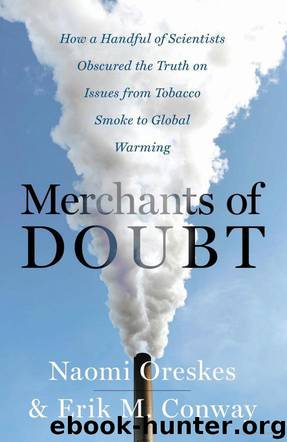Merchants of Doubt: How a Handful of Scientists Obscured the Truth on Issues From Tobacco Smoke to Global Warming by Erik M. Conway; Naomi Oreskes

Author:Erik M. Conway; Naomi Oreskes
Language: eng
Format: mobi
ISBN: 1596916109
Publisher: Bloomsbury Press
Published: 2010-06-03T00:00:00+00:00
Blaming the Sun
In 1984 Bill Nierenberg retired as director of the Scripps Institution of Oceanography, and joined the Board of Directors of the George C. Marshall Institute. As we saw earlier, Robert Jastrow had established the Institute to defend President Reagan’s Strategic Defense Initiative against attack by other scientists. But by 1989, the enemy that justified SDI was rapidly disappearing. The Warsaw Pact had fallen apart, the Soviet Union itself was disintegrating, and the end of the Cold War was in sight. The Institute might have disbanded—its raison d’être disappeared—but instead, the old Cold Warriors decided to fight on. The new enemy? Environmental “alarmists.” In 1989—the very year the Berlin Wall fell—the Marshall Institute issued its first report attacking climate science. Within a few years, they would be attacking climate scientists as well.
Their initial strategy wasn’t to deny the fact of global warming, but to blame it on the Sun. They circulated an unpublished “white paper,” generated by Jastrow, Seitz, and Nierenberg and published as a small book the following year, entitled “Global Warming: What Does the Science Tell Us?”66 Echoing the tobacco industry strategy, they claimed that the report would set the record straight on global warming. The Institute’s Washington office staff contacted the White House to request the opportunity to present it. Nierenberg gave the briefing himself, to members of the Office of Cabinet Affairs, the Office of Policy Development, the Council of Economic Advisers, and the Office of Management and Budget.67
The briefing had a big impact, stopping the positive momentum that had been building in the Bush administration. “I was impressed with the report,” said one member of the cabinet affairs office. “Everyone has read it. Everyone takes it seriously.” Another ruminated, “It is well worth listening to. They are eminent scientists. I was impressed.”68 White House chief of staff John Sununu—a nuclear engineer by training—was particularly taken. Stanford University’s Stephen Schneider lamented, “Sununu is holding the report up like a cross to a vampire, fending off greenhouse warming.”69 Meanwhile, no one had invited Bert Bolin to the White House. Perhaps he hadn’t known to ask to be invited.
The central claim of the Marshall Institute report was that the warming that Hansen and others had found didn’t track the historical increase in CO2. The majority of the warming had been prior to 1940—prior to the majority of the carbon dioxide emissions. Then there was a cooling trend through 1975, and a return to warming. Since the warming didn’t parallel the increase in CO2, it must have been caused, they claimed, by the Sun.70
Drawing on sunspot and carbon-14 data from tree rings, they argued that the Sun had entered a period of higher energy output during the nineteenth century, and that this solar output increase (of about 0.3 percent) was responsible for the climate warming to date. They also contended that the data showed a two-hundred-year cycle, so the warming trend was almost over, and things would soon begin to cool off. “If the correlation between solar activity
Download
This site does not store any files on its server. We only index and link to content provided by other sites. Please contact the content providers to delete copyright contents if any and email us, we'll remove relevant links or contents immediately.
Enlightenment Now: The Case for Reason, Science, Humanism, and Progress by Steven Pinker(7231)
A Journey Through Charms and Defence Against the Dark Arts (Harry Potter: A Journey Through…) by Pottermore Publishing(4781)
The Immortal Life of Henrietta Lacks by Rebecca Skloot(4525)
A Journey Through Divination and Astronomy by Publishing Pottermore(4344)
Elon Musk by Ashlee Vance(4028)
Origin Story: A Big History of Everything by David Christian(3648)
COSMOS by Carl Sagan(3554)
Alchemy and Alchemists by C. J. S. Thompson(3449)
Bad Pharma by Ben Goldacre(3355)
Enlightenment Now by Steven Pinker(3338)
Shadow of Night by Deborah Harkness(3302)
Inferior by Angela Saini(3276)
A Mind For Numbers: How to Excel at Math and Science (Even If You Flunked Algebra) by Barbara Oakley(3218)
Origin Story by David Christian(3147)
The Code Book by Simon Singh(3074)
Signature in the Cell: DNA and the Evidence for Intelligent Design by Stephen C. Meyer(3071)
The Elements by Theodore Gray(2998)
A Brief History of Time by Stephen Hawking(2960)
A Journey Through Potions and Herbology (A Journey Through…) by Pottermore Publishing(2828)
